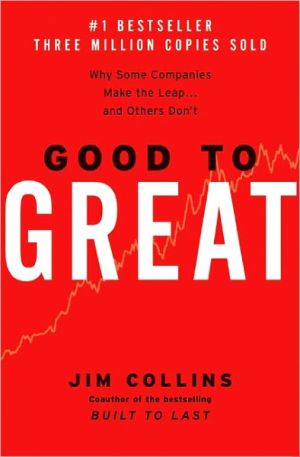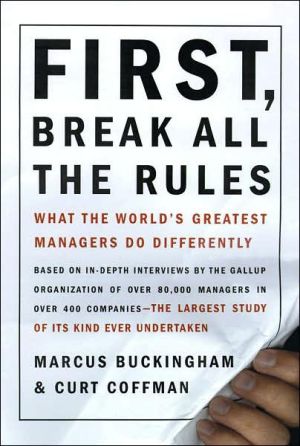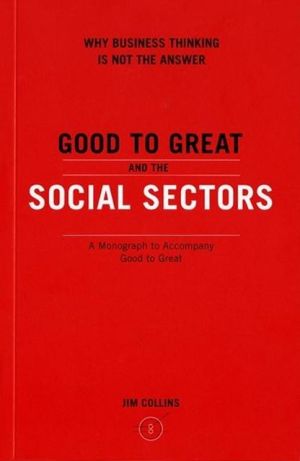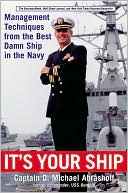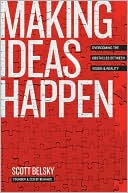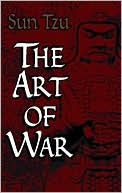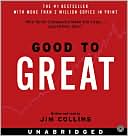Good to Great: Why Some Companies Make the Leap and Others Don't
The Challenge:Built to Last, the defining management study of the nineties, showed how great companies triumph over time and how long-term sustained performance can be engineered into the DNA of an enterprise from the verybeginning. But what about the company that is not born with great DNA? How can good companies, mediocre companies, even bad companies achieve enduring greatness? The Study: For years, this question preyed on the mind of Jim Collins. Are there companies that defy gravity and...
Search in google:
The findings of the Good to Great study will surprise many readers and shed light on virtually every area of management strategy and practice. The findings include: Level 5 Leaders: The research team was shocked to discover the type of leadership required to achieve greatness. The Hedgehog Concept (Simplicity within the Three Circles): To go from good to great requires transcending the curse of competence. A Culture of Discipline: When you combine a culture of discipline with an ethic of entrepreneurship, you get the magical alchemy of great results. Technology Accelerators: Good-to-great companies think differently about the role of technology. The Flywheel and the Doom Loop: Those who launch radical change programs and wrenching restructurings will almost certainly fail to make the leap. Publishers Weekly In what Collins terms a prequel to the bestseller Built to Last he wrote with Jerry Porras, this worthwhile effort explores the way good organizations can be turned into ones that produce great, sustained results. To find the keys to greatness, Collins's 21-person research team (at his management research firm) read and coded 6,000 articles, generated more than 2,000 pages of interview transcripts and created 384 megabytes of computer data in a five-year project. That Collins is able to distill the findings into a cogent, well-argued and instructive guide is a testament to his writing skills. After establishing a definition of a good-to-great transition that involves a 10-year fallow period followed by 15 years of increased profits, Collins's crew combed through every company that has made the Fortune 500 (approximately 1,400) and found 11 that met their criteria, including Walgreens, Kimberly Clark and Circuit City. At the heart of the findings about these companies' stellar successes is what Collins calls the Hedgehog Concept, a product or service that leads a company to outshine all worldwide competitors, that drives a company's economic engine and that a company is passionate about. While the companies that achieved greatness were all in different industries, each engaged in versions of Collins's strategies. While some of the overall findings are counterintuitive (e.g., the most effective leaders are humble and strong-willed rather than outgoing), many of Collins's perspectives on running a business are amazingly simple and commonsense. This is not to suggest, however, that executives at all levels wouldn't benefit from reading this book; after all, only 11 companies managed to figureout how to change their B grade to an A on their own. (Oct.) Copyright 2001 Cahners Business Information.
Chapter One\ \ \ Good is the Enemy of Great\ \ \ That's what makes death so hard -- unsatisfied curiosity.\ \ --Beryl Markham,\ West with the Night\ \ \ Good is the enemy of great.\ And that is one of the key reasons why we have so little that becomes great.\ We don't have great schools, principally because we have good schools. We don't have great government, principally because we have good government. Few people attain great lives, in large part because it is just so easy to settle for a good life. The vast majority of companies never become great, precisely because the vast majority become quite good -- and that is their main problem.\ This point became piercingly clear to me in 1996, when I was having dinner with a group of thought leaders gathered for a discussion about organizational performance. Bill Meehan, the managing director of the San Francisco office of McKinsey & Company, leaned over and casually confided, "You know, Jim, we love Built to Last around here. You and your coauthor did a very fine job on the research and writing. Unfortunately, it's useless."\ Curious, I asked him to explain.\ "The companies you wrote about were, for the most part, always great," he said. "They never had to turn themselves from good companies into great companies. They had parents like David Packard and George Merck, who shaped the character of greatness from early on. But what about the vast majority of companies that wake up partway through life and realize that they're good, but not great?"\ I now realize that Meehan was exaggerating for effect with his "useless" comment, but his essential observation was correct -- that truly great companies, for the most part, have always been great. And the vast majority of good companies remain just that -- good, but not great. Indeed, Meehan's comment proved to be an invaluable gift, as it planted the seed of a question that became the basis of this entire book -- namely, Can a good company become a great company and, if so, how? Or is the disease of "just being good" incurable?\ Five years after that fateful dinner we can now say, without question, that good to great does happen, and we've learned much about the underlying variables that make it happen. Inspired by Bill Meehan's challenge, my research team and I embarked on a five-year research effort, a journey to explore the inner workings of good to great.\ In essence, we identified companies that made the leap from good results to great results and sustained those results for at least fifteen years. We compared these companies to a carefully selected control group of comparison companies that failed to make the leap, or if they did, failed to sustain it. We then compared the good-to-great companies to the comparison companies to discover the essential and distinguishing factors at work.\ The good-to-great examples that made the final cut into the study attained extraordinary results, averaging cumulative stock returns 6.9 times the general market in the fifteen years following their transition points. To put that in perspective, General Electric (considered by many to be the best-led company in America at the end of the twentieth century) outperformed the market by 2.8 times over the fifteen years 1985 to 2000. Furthermore, if you invested $1 in a mutual fund of the good-to-great companies in 1965, holding each company at the general market rate until the date of transition, and simultaneously invested $1 in a general market stock fund, your $1 in the good-to-great fund taken out on January 1, 2000, would have multiplied 471 times, compared to a 56 fold increase in the market.\ These are remarkable numbers, made all the more remarkable when you consider the fact that they came from companies that had previously been so utterly unremarkable. Consider just one case, Walgreens. For over forty years, Walgreens had bumped along as a very average company, more or less tracking the general market. Then in 1975, seemingly out of nowhere -- bang! -- Walgreens began to climb...and climb...and climb...and climb...and it just kept climbing. From December 31, 1975, to January 1, 2000, $1 invested in Walgreens beat $1 invested in technology superstar Intel by nearly two times, General Electric by nearly five times, Coca-Cola by nearly eight times, and the general stock market (including the NASDAQ stock run-up at the end of 1999) by over fifteen times.\ How on earth did a company with such a long history of being nothing special transform itself into an enterprise that outperformed some of the best-led organizations in the world? And why was Walgreens able to make the leap when other companies in the same industry with the same opportunities and similar resources, such as Eckerd, did not make the leap? This single case captures the essence of our quest.\ This book is not about Walgreens per se, or any of the specific companies we studied. It is about the question -- Can a good company become a great company and, if so, how? -- and our search for timeless, universal answers that can be applied by any organization.\ Our five-year quest yielded many insights, a number of them surprising and quite contrary to conventional wisdom, but one giant conclusion stands above the others: We believe that almost any organization can substantially improve its stature and performance, perhaps even become great, if it conscientiously applies the framework of ideas we've uncovered.\ \ \ This book is dedicated to teaching what we've learned. The remainder of this introductory chapter tells the story of our journey, outlines our research method, and previews the key findings. In chapter 2, we launch headlong into the findings themselves, beginning with one of the most provocative of the whole study: Level 5 leadership.\ Undaunted Curiosity\ \ \ People often ask, "What motivates you to undertake these huge research projects?" It's a good question. The answer is, "Curiosity."...
\ From Barnes & NobleThe Barnes & Noble Review\ Jim Collins begins this book with a startling and counterintuitive claim: "Good is the enemy of great." We've become so conditioned to think of performance as something that develops along evolutionary lines -- from poor to good to outstanding -- that it takes a minute to grasp the notion that competence can actually inhibit achievement. As Collins says, "The vast majority of companies never become great, precisely because the vast majority become quite good -- and that is their main problem." \ Based on an extensive five-year study conducted by Collins and a research team he affectionately refers to as "the Chimps," Good to Great defines and analyzes the practices that allowed 11 companies to make the rare transition from solid to outstanding performance. One of the first surprises of the book is the list of companies Collins focuses on: Circuit City, Gillette, Walgreens, and Wells Fargo haven't been touted as top performers in that way that GE or Coca-Cola, for instance, have. Nonetheless, the companies chosen have all met the rigorous criteria that Collins developed to measure the good-to-great transition. Some of the other revelations in the book concern the lack of correlation between executive compensation and corporate performance; the fact that technology did not in itself engender corporate transformation; and the scant attention that these upward-trending companies paid to such issues as managing change or motivating people.\ Collins's philosophy is summed up in one noteworthy phrase from the book -- "Greatness is not a function of circumstance. Greatness, it turns out, is largely a matter of conscious choice." Anyone who wants to make the right choices for their business will find Good to Great instructive, accessible, and well worth reading. It is sure to be a business book that will be consulted and referred to for years to come. (Sunil Sharma)\ \ \ \ \ \ Business WeekOne of the top ten business books of 2001\ \ \ Publishers WeeklyIn what Collins terms a prequel to the bestseller Built to Last he wrote with Jerry Porras, this worthwhile effort explores the way good organizations can be turned into ones that produce great, sustained results. To find the keys to greatness, Collins's 21-person research team (at his management research firm) read and coded 6,000 articles, generated more than 2,000 pages of interview transcripts and created 384 megabytes of computer data in a five-year project. That Collins is able to distill the findings into a cogent, well-argued and instructive guide is a testament to his writing skills. After establishing a definition of a good-to-great transition that involves a 10-year fallow period followed by 15 years of increased profits, Collins's crew combed through every company that has made the Fortune 500 (approximately 1,400) and found 11 that met their criteria, including Walgreens, Kimberly Clark and Circuit City. At the heart of the findings about these companies' stellar successes is what Collins calls the Hedgehog Concept, a product or service that leads a company to outshine all worldwide competitors, that drives a company's economic engine and that a company is passionate about. While the companies that achieved greatness were all in different industries, each engaged in versions of Collins's strategies. While some of the overall findings are counterintuitive (e.g., the most effective leaders are humble and strong-willed rather than outgoing), many of Collins's perspectives on running a business are amazingly simple and commonsense. This is not to suggest, however, that executives at all levels wouldn't benefit from reading this book; after all, only 11 companies managed to figureout how to change their B grade to an A on their own. (Oct.) Copyright 2001 Cahners Business Information.\ \ \ \ \ Library JournalCollins follows his successful Built To Last (coauthor, with Jerry Porras), which showed how companies triumph over time, with this extensive analysis of how good, mediocre, and even bad companies can achieve enduring greatness. Collins led a research team of 21 members who analyzed data on 1,435 companies, looking for the few that made substantial improvements in their performance over time. The 11 featured businesses, which earned the "good-to-great" label, outperformed the market by a multiple of at least three over a 15-year period and were able to sustain their success for at least 15 years. They include Circuit City, Fannie Mae, Kimberly Clark, Phillip Morris, and Wells Fargo. The author reveals common traits that distinguish these companies from comparison firms that failed to reach a similar level of success. Collins's deeply earnest narration is heightened by his obvious zeal for the material, further enhancing this solid content that will likely have more staying power than Tom Peters's In Search of Excellence. Highly recommended for larger public libraries and university libraries supporting a business curriculum.-Dale Farris, Groves, TX Copyright 2006 Reed Business Information.\ \ \ \ \ Soundview Executive Book SummariesIn his previous bestseller, Built to Last, Jim Collins explored what made great companies great and how they sustained that greatness over time. One point kept nagging him, though - great companies have, for the most part, always been great, while a vast majority of good companies remain just that: good, but not great. What could merely good companies do to become great, to turn long-term weakness into long-term supremacy?\ Collins and his team of researchers used strict benchmarks to identify a group of 11 elite companies that made the leap from good to great and sustained that greatness for at least 15 years. The real surprise of Good to Great is not so much what good companies do to propel themselves to greatness - it is why more companies have not done the same things more often.\ The author and his team of researchers established these good-to-great benchmarks:\ \ The companies had to have experienced 15-year cumulative stock returns that were at or below the general stock market, punctuated by a transition point, then cumulative returns at least three times the market over the next fifteen years.\ Each company had to demonstrate the good-to-great pattern independent of its industry.\ Each company had to demonstrate a pattern of results.\ Each company was compared to other similar companies that either never made the good-to-great leap (or made it but did not sustain it), in order to determine what distinguished the good-to-great company from all others.\ \ \ \ \ When the dust cleared and the good-to-great companies were identified, the author and his researchers found distinct patterns of behavior in those who led each company and the people who followed them - patterns that concerned disciplined people, thought and action.\ Level 5 Leadership\ One of the most surprising results of the research was in the discovery of the type of leadership required to turn a good company into a great one. One might think that such companies are led by high-profile leaders with big personalities who make headlines and become celebrities.\ Yet, Collins found that those leaders who seek and thrive in the spotlight do not exude what can be termed "Level 5 Leadership" behaviors. (The term Level 5 refers to the highest level in a hierarchy of executive capabilities.) Leaders of this type -those who combine extreme personal humility with intense professional will - shun the attention of celebrity, channeling their ambition toward the goal of building a great company. Collins explains that these leaders all set up successors for success, are compellingly modest, and have unwavering resolve.\ He also found that good-to-great leaders understand three simple truths:\ \ If you begin with the "who," rather than the "what," you can more easily adapt to a changing world.\ If you have the right people on the bus, the problem of how to motivate and manage people largely goes away.\ If you have the wrong people, it doesn't matter whether you discover the right direction - you still won't have a great company.\ \ \ \ \ All good-to-great companies began the process of finding a path to greatness by confronting the brutal facts of their current reality. Collins found that when a company starts with an honest and diligent effort to determine the truth of its situation, the right decisions often become self-evident.\ One of the primary tasks in taking a company from good to great is to create a culture wherein people have a tremendous opportunity to be heard and, ultimately, for the truth to be likewise heard. Collins writes that, to create a culture of discipline, successful leaders:\ \ Build a culture around the idea of freedom and responsibility, within a framework.\ Fill the company's culture with self-disciplined people who are willing to go to extreme lengths to fulfill their responsibilities.\ Do not confuse a culture of discipline with a tyrannical discipline.\ \ \ \ \ Collins also found that good-to-great organizations think differently than mediocre organizations about technology and technological change. They avoid the fads and bandwagons that typically arise from new technology, instead becoming pioneers in the application of carefully selected technologies. Leaders of good-to-great companies respond with thoughtfulness and creativity, driven by a compulsion to turn unrealized potential into results. They act in terms of what they want to create, and how to improve their companies, relative to an absolute standard of excellence.\ Good-to-great transformations often look like dramatic, revolutionary events to those observing from the outside, but they feel like organic, cumulative processes to people on the inside. Collins writes that good-to-great companies had no name for their transformations; there was no launch event, no tag line, no programmatic feel whatsoever. Collins explains that each company went through a quiet, deliberate process of figuring out what needed to be done to create the best future results, then simply took those steps, one by one over time, until it hit breakthrough moments.\ Why Soundview Likes This Book\ Collins has taken exemplary research and turned it into a book that redefines what it takes to become a great company. His eye-opening insights and sharp historical perspective support the valid and important conclusions he reaches. By debunking many myths about what it takes to make a company succeed, he points leaders in the right direction to turn competence into excellence. Copyright (c) 2002 Soundview Executive Book Summaries\ \ \
